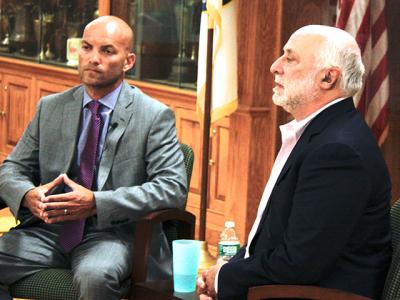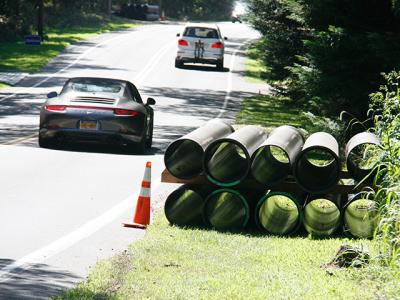Seeking State Go-Ahead
Seeking State Go-Ahead

Deepwater Wind, the Rhode Island company seeking to construct the 15-turbine South Fork Wind Farm in an area leased from the federal government about 30 miles offshore from Montauk, plans to submit an application for the wind farm’s transmission cable to the New York State Public Service Commission in the next week. The company submitted a construction and operations plan for the installation to the federal Bureau of Ocean Energy Management in June, and an application to the U.S. Army Corps of Engineers is to be submitted in the coming weeks.
Clint Plummer, Deepwater Wind’s vice president of development, said last Thursday that the application to the P.S.C. will include Beach Lane in Wainscott as the transmission cable’s preferred route, where it is to make landing from the wind farm. It would then be buried along a route to a Long Island Power Authority substation near Cove Hollow Road in East Hampton.
The P.S.C. oversees components of the project that lie within state waters, including portions of the transmission cable, and those buried under state roads or rights of way, as well as the interconnection facilities to be built at the LIPA substation. The agency will determine whether to issue a certificate of environmental compatibility and public need, as required under the review process known as Article VII, which covers applications to construct and operate a major electric transmission facility.
Deepwater’s move follows the East Hampton Town Board’s 3-to-2 vote in July to support the granting of an access and utility easement allowing the company to land the cable at the ocean beach at the end of Beach Lane, and the town trustees’ Aug. 27 vote to retain Daniel Spitzer, an attorney who is to guide the trustees in negotiating a land-use agreement and through the Article VII process.
In its July vote, the town board also voted to hire an attorney, John Wagner, to serve as outside counsel to the town attorney’s office for issues relating to the wind farm, including proceedings pursuant to Article VII and before the federal agency and other regulatory bodies.
“Because we have the votes that show an indication of interest by the town and trustees, we’re moving forward in good faith,” Mr. Plummer said. “But since we don’t have agreements finalized, we are including a viable alternative,” referring to a landing site on state-owned land at Hither Hills. “If we don’t get an agreement, we will land at Hither Hills and connect at the [East Hampton] substation,” bypassing land that may be under trustee jurisdiction.
The Beach Lane landing has drawn criticism, particularly from Wainscott residents who are concerned about the environmental impact on the beach. Deepwater Wind plans to drill horizontally, beginning several hundred yards offshore and continuing under the beach, to create a tunnel into which a conduit will be laid, the high-voltage transmission cable contained within it.
A petition opposing the Wainscott landing began circulating late last month and is to be delivered to the town board.
More broadly, many residents are opposed to the wind farm entirely. Commercial fishermen and their advocates say that the electromagnetic field emanating from the transmission cable might alter fish migration patterns, possibly repelling some species while attracting others.
Deepwater Wind has offered an $8.45 million community-benefits package to the town, which would fund sustainability programs and infrastructure improvements, in exchange for the easement. Should the town and trustees deny Deepwater Wind an easement to land its cable, the offer will be withdrawn, the company’s officials say.
Adjacent property owners along both routes will be notified on or about the day the application is submitted to the P.S.C., Mr. Plummer said, with instructions on how to access additional information. The commission is to review it for completeness. It will be posted to the P.S.C.’s website and at southforkwindfarm.com, and print copies will be available at locations in East Hampton Town and Village, including the Montauk Library.
The construction and operations plan, which a developer is required to submit within five years of receiving an offshore renewable-energy lease from the federal government, will also be made public once the Bureau of Ocean Energy Management deems it complete. That is expected in mid-October, according to Deepwater Wind. Public hearings, including one in East Hampton, will follow.
Mr. Spitzer attended the trustees’ meeting on Monday, and was to have met with them and with stakeholders, including representatives of the commercial fishing industry, on Tuesday.
Julia Prince, Deepwater Wind’s Montauk manager and fisheries liaison, “has been on the docks and has been letting folks know we are submitting the application,” Mr. Plummer said.




